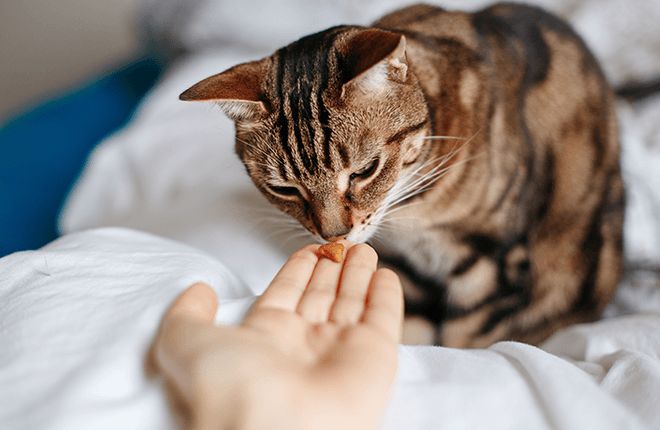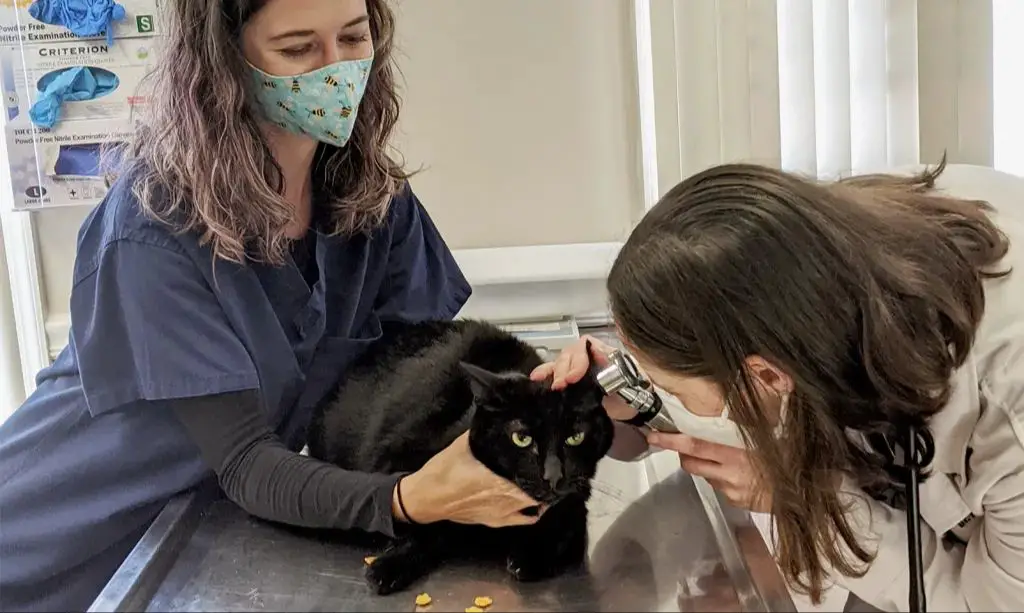What is Catnip and How Does it Affect Cats?
Catnip is an herb that belongs to the mint family and contains a chemical called nepetalactone. This chemical triggers a response when inhaled or ingested by cats (1). The response can vary but most commonly includes behaviors like rolling, flipping, rubbing, and eventually zoning out. Cats may also meow or growl during this response. Other cats become hyperactive or overly playful after exposure to catnip (2).
The effects of catnip last around 5-15 minutes before wearing off. Afterwards, cats need to rest for at least an hour before catnip will have the same effect again (1). Catnip does not appear to have any long-lasting effects on cats and is generally considered safe when used appropriately.
Sources:
(1) https://www.humanesociety.org/resources/crazy-catnip
(2) https://www.petmd.com/cat/general-health/what-is-catnip
Can Catnip Also Affect Dogs?
While catnip is well known for its intoxicating effects on cats, the herb does not have the same effect on all dogs. This is because catnip contains an oil called nepetalactone which binds to olfactory receptors in a cat’s nose, creating a euphoric reaction. However, most dogs do not have the same receptors and are not affected by nepetalactone in the same way.
That said, some dogs do respond to catnip, likely due to genetic factors. A 2017 study found that around 20-30% of dogs showed a response to catnip, displaying behaviors like rolling around, shaking their head, and vocalizing when exposed to the herb. The response was also found to be hereditary, with dogs more likely to react if their parents did as well.
So while catnip does not induce a high in most dogs like it does in cats, a minority of dogs do seem responsive. The reaction varies from dog to dog but may include playfulness, hyperactivity, sniffing, chewing on, or rolling around in catnip toys and treats.
Using Catnip for Dog Anxiety

Catnip can have a calming effect and be used to help relieve anxiety in dogs. According to Doggijuana, catnip contains nepetalactone which binds to olfactory receptors in a dog’s nose, triggering a response that has a calming effect [1]. This can help dogs who suffer from various types of anxiety such as separation anxiety, fear of loud noises, vet visits, travel, or other stressful situations [2].
The relaxing properties of catnip can help relieve anxiety symptoms like panting, pacing, whining, barking, restlessness and destructive behaviors. The calming effect helps dogs feel more at ease and relaxed. Catnip should not be used as a sole treatment for serious anxiety issues but can be a helpful supplement when combined with training, environmental changes, and other techniques recommended by your veterinarian or professional trainer.
Administering Catnip to Dogs
There are several ways to give catnip to dogs, which allows owners to choose the method that works best for their pet. Some options include:1
Dried catnip – The dried leaf and flower tops can be crumbled or ground into a powder and sprinkled on your dog’s food. This allows the dog to ingest the catnip when eating.
Catnip tea – Steep dried catnip in hot water for 10-15 minutes to extract the oils. Let cool and then mix the tea into your dog’s water or food bowl. The tea can also be used to fill toys that dispense liquid.
Catnip extracts or oils – These concentrated forms may be droppers directly into your dog’s mouth or mixed with food. Use caution with oils and follow dosage guidelines.
Giving catnip in one of these forms allows your dog to safely ingest it and experience any anti-anxiety benefits. Monitor your dog’s reaction and adjust the amount given as needed. Consult your vet if unsure about proper dosing.

Dosage Guidelines
When administering catnip to dogs for anxiety, it’s important to follow the proper dosage guidelines. The dosage will depend on several factors:
Dog’s size – Small dogs generally need less catnip than larger breeds. A good rule of thumb is:
- 1/4 teaspoon for small dogs
- 1/2 teaspoon for medium dogs
- 1 teaspoon for large dogs
Type of product – Catnip can be given dried, as an oil, or in treats/toys. Oils and extracts will be more concentrated so adjust dosage accordingly.
Concentration – If using a catnip product designed for dogs, follow label instructions carefully regarding dosage. Some contain higher potency catnip which requires less volume.
It’s best to start with smaller amounts and gradually increase until you find the optimal dosage for your dog’s needs. Always supervise your dog closely when first using catnip and monitor for side effects.
Consult your veterinarian if you are unsure of the proper dosage. Overdose is possible so accurate dosage based on product and dog size is important for safety.
Safety Precautions
Although catnip is generally considered safe for dogs, there are some precautions you should take when giving it to your dog:
Overdose – Giving too much catnip to dogs can cause adverse effects like vomiting and diarrhea. It’s important to start with small doses and gradually increase to ensure your dog tolerates it well.
Introducing Slowly – Even if you start with an appropriate dose, introducing any new substance slowly and monitoring your dog’s reaction is advised. Some dogs may have sensitivities.
Consistency – Only buy catnip from reputable sources to ensure what you’re giving your dog is uncontaminated. The potency can vary between batches, so stick to the same brand.
Monitoring – Pay attention to your dog’s behavior after administering catnip. Look for any concerning symptoms like lethargy or hyperactivity that last longer than expected.
Safety – Don’t let your dog have unlimited access to catnip. It should be treated like an occasional treat. Keep it safely stored when not in use.
Talk to your vet if you have any concerns about using catnip for your anxious dog. They can provide tailored dosage and safety guidance.
Other Anti-Anxiety Options
In addition to catnip, there are some other natural options to help ease anxiety in dogs including:
Pheromones – Pheromones are chemicals released by animals that trigger social responses in members of the same species. Synthetic dog appeasing pheromones (DAP) mimic natural calming pheromones and help reduce anxiety behaviors when used in diffusers or collars (source).
Thundershirts – These snug-fitting wraps apply gentle, constant pressure that has a calming effect on many dogs during stressful situations like thunderstorms, car rides or separation anxiety. The compression can help relieve anxiety similarly to swaddling an infant (source).
CBD Oil – CBD is a compound derived from cannabis and hemp plants. Some dog owners have found CBD oil helps relieve anxiety, but dosing can be tricky and scientific evidence is still limited. Consult a vet before trying CBD oil for dog anxiety (source).
Training – Behavioral modification training, desensitization and counterconditioning can help dogs overcome anxiety triggers and teach calmer responses. A certified professional dog trainer or veterinary behaviorist can create an effective training plan tailored to a dog’s unique needs.
When to See a Vet
While catnip may help relieve mild anxiety in dogs, it is not a cure-all. If your dog suffers from moderate to severe anxiety that persists even after trying catnip, it’s important to take them to the vet.
A veterinarian can help determine if there is an underlying medical issue causing the anxiety. They can also prescribe stronger anti-anxiety medications like fluoxetine and clomipramine that are formulated specifically for dogs.

According to the AKC, medications like SSRIs and antidepressants may be recommended for serious anxiety disorders. These prescription medications are often more effective at treating severe anxiety compared to over-the-counter remedies.
While natural methods like catnip, soothing pheromones, and supplements can help, they may not be enough for chronic, debilitating anxiety. If your dog’s anxiety persists and interferes with their normal activities, take them to the vet as soon as possible.
With prescription medication and behavior therapy, it’s possible to manage even severe anxiety and help your dog live a happier, more relaxed life.
Cats and Dog Anxiety
While catnip can have a calming effect on anxious dogs, it’s important to keep the catnip out of reach of your cats if you also have a dog that needs it for anxiety. When cats are exposed to catnip, it acts as a stimulant and can make cats hyperactive, playful, and energetic. You don’t want your anxious dog to be around the cats when they’re in this excited state, as it can exacerbate the dog’s anxiety.
It’s best to give your dog catnip in an area away from the cats, such as a crate or separate room. Never leave catnip toys or loose catnip leaves laying around open areas of your home where your cats can access it. The stimulant effects typically last 5-15 minutes in cats, but can be longer depending on the cat and amount consumed. Once the catnip wears off, it’s safer for your anxious dog to interact normally with the cats.
By keeping the catnip securely away from cats in your household, you can use its calming benefits for your anxious dog without causing overstimulation in the cats that could negatively impact your dog.
Catnip as Part of a Holistic Approach
While catnip can provide some anti-anxiety benefits, it should be combined with other methods for a holistic approach to managing dog anxiety. Some additional techniques include:
- Environmental changes – Minimizing loud noises, high activity levels, and other triggers can remove sources of stress.
- Training and counterconditioning – Helping a dog associate triggers with positive outcomes can change their emotional response. This should be done gradually with reward-based methods.
- Exercise and enrichment – Providing adequate physical and mental stimulation through walks, play, puzzles, etc. can reduce restlessness.
- Routine – Establishing consistent schedules and routines can build confidence.

A holistic approach combines medical, environmental, behavioral and lifestyle components tailored to your dog’s needs. Catnip may provide some relief, but should be paired with these other science-backed techniques for better management of anxiety long-term.

